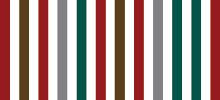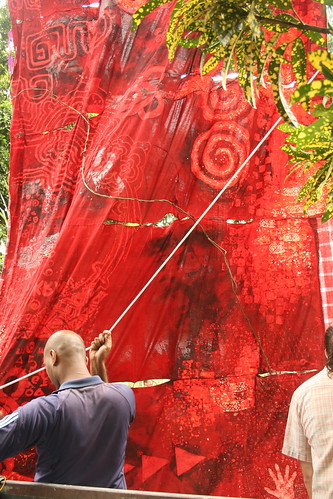
Artist Sunil Puljuhn assists with the installation of Sri Irodikromo's Ingiwinti in the DSB garden; photo by Christopher Cozier
The Paramaribo SPAN exhibition opens at 7.30 pm this evening in the grounds of De Surinaamsche Bank's headquarters on Henck Arron Straat.
Artists Dhiradj Ramsamoedj and Ken Doorson in the DSB garden; photo by Christopher Cozier
Artist Karel Doing helps Sri Irodikromo during the installation of her Ingiwinti; photo by Christopher Cozier
Opening night
Friday, February 26, 2010
Programme: Readytex Art Gallery “art fatu”
Thursday, February 25, 2010
Readytex director Monique Nouhchaia Sookdewsing talks to SPAN co-curator Christopher Cozier
Founded in 1993 by Monique Nouhchaia Sookdewsing, the Readytex Art Gallery in downtown Paramaribo is Suriname's leading commercial gallery. Many of the artists participating in the SPAN project — including Sri Irodikromo, Kurt Nahar, Marcel Pinas, Dhiradj Ramsamoedj, George Struikelblok, Roddney Tjon Poen Gie, and Jhunry Udenhout — show their work at Readytex or are represented by the gallery. As SPAN co-curator Christopher Cozier remarks, Readytex — on the second floor of a large commercial building on Maagdenstraat, also occupied by other branches of Nouchaia's family business — is an obligatory stop on Suriname's art circuit.
The programme of activities on the Paramaribo SPAN opening weekend includes several events outside the main exhibition venue at the DSB headquarters, all intended to broaden SPAN's conversation about the contemporary art scene in Suriname. On Saturday 27 February at 10 a.m., the Readytex Art Gallery will host an art "fatu" — an informal gathering — for the participating artists and organisers, visiting critics and curators, and other invited guests. Works by a range of contemporary Surinamese artists will be on display, and Nouhchaia will discuss plans for the new cultural centre she will open in March 2010.
Diary: three days to the opening
Tuesday, February 23, 2010

Detail of Ravi Rajcoomar's SPAN installation
With three days remaining until the opening of the Paramaribo SPAN exhibition, all the members of the SPAN curatorial and organising team are now in Paramaribo, and installation of the artists' works is almost complete at the main exhibition venue, the DSB garden.
Roddney Tjon Poen Gie working on his installation at the DSB garden. His project is a collaboration with photographer Sirano Zalman
The former director's villa and extensive grounds behind De Surinaamsche Bank's headquarters provide numerous indoor and outdoor spaces for works by twenty-nine Surinamese and Dutch artists, some of them created specifically for these sites. On opening night, Friday 26 February, the DSB garden will be illuminated by thousands of lights as guests encounter works including painting, photography, sculpture, installation, video, and several performance projects.
Sri Irodikromo installing her work in the DSB garden
Sunil Puljhun helps install Irodikromo's work
Labels: diary, irodikromo, puljhun, rajcoomar, tjon poen gie
Notes: on monuments and moments
Friday, February 19, 2010
By Christopher Cozier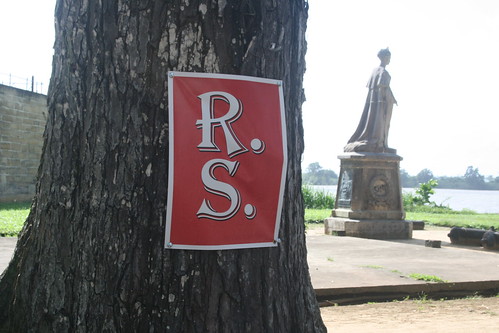
Kurt Nahar’s 8 Dec 1982 installation at Fort Zeelandia; photo by Christopher Cozier
Often when I think of monuments in the Caribbean I think only of the commemoration of historically remote events, and most of the time in a passive and almost indifferent way. We think of a lost moment and of the attempt to preserve or project its value. These questions have been with me since my first visits to Paramaribo, observing the projects of artists Marcel Pinas and Kurt Nahar. There are so many commemorative statues and structures in this city. Somehow they seem to reduce rather than to expand or ignite curiosity. They just fit in, and the snow-cone cart, concert poster, or bus decoration seems to register more definitively or assertively on my mind. As in many other Caribbean locations, there remains a tension between formal and informal markers as you move around Paramaribo.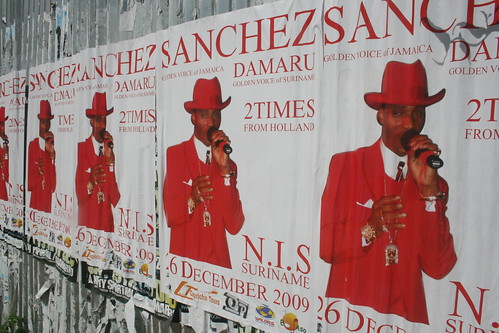
Concert poster, Paramaribo; photo by Christopher Cozier
Kurt Nahar’s project at Fort Zeelandia, 8 Dec 1982, refers to the date of what are called the December Killings. Fifteen people — trade unionists, journalists, academics, and soldiers — known to be opposed to the government, were rounded up, interrogated, tortured, and killed in this fort.
Marcel Pinas’s Moiwana monument commemorates the November 1986 massacre of over thirty men, women, and children during Suriname's civil war, at the actual site of the tragedy on the road between Moengo and Albina. This was the home of the rebel leader Ronnie Brunswijk.
Both artists bring up ideas about how or why we should remember in ways that are circumspect about nationhood’s promises. They bring up issues about the relationship between art and local politics in a fragile democracy. They take this on in an era very different from that of Waka Tjopu, for example, a moment traditionally associated with political engagement and the social value of visual production. A time when terms like “struggle” and “progressive” had a particular charge.
For Pinas and Nahar, these investigative works fuse ideas of personal and collective interests reaching beyond the immediate moment or place. They seek to interrogate the purpose of visual production and the strategies of articulating the challenges of contemporary Caribbean society. As a Ndjuka, Pinas has been articulating presence and visibility throughout his entire career by highlighting the visual language, culture, and social challenges of his community. Nahar, from an urban “creole” backgound, has incorporated this event into his practice. Through the dissonance of associative random fragments on the surface of his collages, he assembles an alternate view of our reality by abandoning the rational to rearrange and re-see. His ongoing interrogative stance and process collides with or arrives at this current political moment.
Optimistically and confidently, both artists test out the boundaries of visual and political propriety by referring to these events. It is counter-politics to the manufacture of fear by insecure aggressive regimes. The December Killings were intended to erase opposition while strategically inserting violated ghosts into the daily imagination of the political class. It generated silence while asserting itself into everyday consciousness. Nahar has worked with and around this once unmentionable moment, re-conjuring it to alter the value of how it resides in our memories.
The vengeful acts of Moiwana were aimed at a particular community then residing outside the coastal political embrace that stood in for what is politically called Suriname. Pinas has built a large-scale monument on the actual site in a forceful declarative manner. It is a site for personal rememberance of lost friends and relatives, for ethnic and national reflection, and also an aesthetic/experiential artistic site-specific-work.
Both artists list names and events in their projects. One gesture is temporal, hoping to trigger memory, undermine silence, and generate debate. The other is a permanent structure, monumental in scale, creating a new mapping of social history — a new site for all of us from the wider region to visit and to experience. The Afaka characters on the Moiwana monument (Kibii wi — “protect us”) refer to community and protection. They ask the rest of us why can’t we just live together. This is not a challenge in Suriname alone.
Marcel Pinas at his Moiwana monument; photo by Christopher Cozier
Both of these works talk about very recent and current experiences, events that are still raw and unresolved within living memory. They acknowledge and construct another narrative about the region by rethinking nation/culture and its construction. These gestures have to be seen within the wider narrative of the Caribbean’s social and political history, and also at the boundary of where it meets with that of South America. These works are aimed at political futures. Another election is coming, and the various players of these moments are still alive and among us. The artists want us to remember, but also to imagine a future that can resolve and transform the meaning and the value of these moments.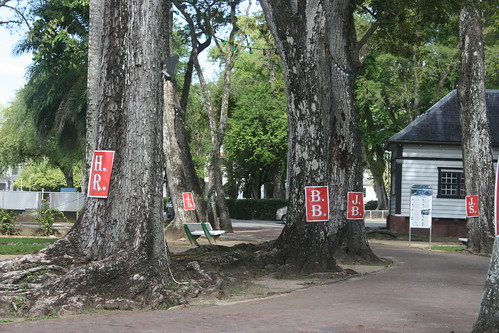

Kurt Nahar’s 8 Dec 1982 installation at Fort Zeelandia; photo by Christopher Cozier
Nahar’s “agitational” mode jettison aesthetic concerns and consciously aims to be caustic — even obnoxious. The way the work is put together expresses an unease, discomfort, and even anger — it seems to be about denying pleasure. One minor concern could be the political implications of the commodification of the December Killings and the expedient usage of the event within electoral politics by interest groups and registered parties. Some have speculated that Nahar’s ongoing concern may also begin to condense the meaning and the possible value of the revolutionary in our historical narrative, and may then obscure what was otherwise accomplished and that may remain unresolved on the road out of colonialism.
Nahar is expressing his concern for the future of his country through highlighting one of its darkest and most challenging moments. He is asking how we can move forward from these unresolved moments. It is a feeling shared throughout the Caribbean, as during the 1980s a number of horrific acts of violence haunted our revolutionary movements and remain with us mostly in popular music, poetry, marginal academic texts, and now more and more through the visual.
Nahar’s strategic lack of composure becomes his way of expressing rage and outrage. The objects are roughly put together, and talk about fragmentation and disharmony and anxiety. Is he asserting that nothing beautiful can come of or from this moment, especially if it remains suppressed and virulent? The work expresses a grasping or gasping — an outburst from a prolonged silence. Unlike the works of previous generations, Nahar is not declaring or invoking an ideal — he is rubbing the lamp, acknowledging a festering reality.
Scattered between the trees around the Fort, which he refers to as “silent witnesses”, bright red posters with the bold initials of the assassinated individuals were nailed to their trunks like sacrificial figures. They looked like standard cheap election posters with their inelegant typography, but instead of smiling, promising faces and catchphrases we got lines of poetry and then just initials. The jarring red tone suggests the violence and the bloodletting of the early 80s as ideological engines, local and internationalist struggles began to simmer. I think of Grenada, Guyana, Trinidad, and Jamaica, as well as other parts of the continent. The internal struggles and the official reactions from Greenbay to Lopinot still haunt us. The heady brew of revolutionary rhetoric and dew breakers, hit squads acting with impunity to maintain the status quo or the Revo from the north to the south of Reagan’s back garden, what was called the Caribbean Basin, are all conjured.
How does a new generation deal with this odd and rapacious Oedipal mask? Does this work then betray the “value” of this revolutionary moment — limit or interrupt its passage into memory and understanding by overstating its darker manifestations, as it allegedly defended its process? Does it highlight the blood-thirsty rationalizations of its imposed optimism and unfulfilled promises?
One can say that the work does not ask about the past as much as it asks about the current moment and the future we are in the process of making — or, as some thinkers suggest, the past imagined futures in which we now reside. That these kinds of political artistic statements can be made now, in Paramaribo, asks an important question about the current state of Surinamese democracy. Will this moment last beyond the outcome of the next election? It also asks about the degree to which artistic expression is seen as agentive or as a large enough social concern. Is it seen as persuasive? It questions the troublesome and vicarious relationship with us, the curators, critics, and exchange artists, with foreign passports and return flights.
Marcel Pinas visiting his Moiwana monument; photo by Christopher Cozier
Pinas’s monument is also operating in this space of questioning. His calm and more composed spatial work looks towards creating an awareness of a newer, more current and pressing question. Ironically, the “creole” nationalist regimes of the region create monuments to rebellion and Emancipation and some even use Maroon culture to symbolise national and cultural resistance within these narratives. Regional monuments speak about the negotiated moment and the gift of freedom towards citizenship for owned entities, ex-slaves but still subjects of the various Crowns within the engine of Modernity.
Cuffy (in Guyana) rages as a primal mystical force, Makandal (in Haiti) blows his shell, Bussa (in Barbados) shakes his fist at the sky (with nice shorts). Two naked and pre-Black statues look at each other not yet aroused in Kingston, like the first steps after the customary drum roll of a Carifesta choreography. And so it goes. Pinas’s work declares a space for thinking, for reflection, rather than objectifying or caricaturing. Is there a way that these officially installed objects obscure or silence unresolved questions about the transformation we hurriedly celebrate in the Post-Independence space?
But the Moiwana monument asks a question or declares an intention about shared space and community. This is not a narrative of subjected fusion, but one about each cultural self remaining intact while connecting and communicating. The work also ventures into inscribing new regional monuments or moments for reflection — new sites of memory and commemoration.
So this gesture is both a personal and a community concern, national and transnational. It recognises those made absent not just in the massacre but in the social dynamics of the country itself. It speaks not just to Suriname but through its scale to all humanity when we falter. Recent events in Albina indicate the fragility of these relations, and the resentments shaped by a long history of neglect.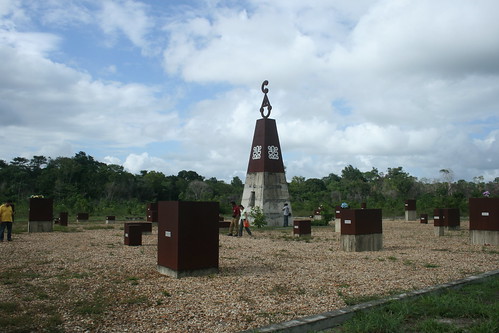
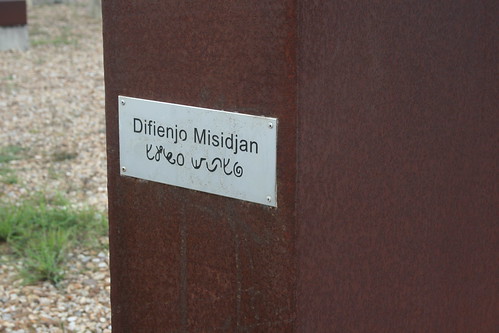
Marcel Pinas’s Moiwana monument; photos by Christopher Cozier
Pinas’s rising object with Afaka signs surrounded by smaller metal and concrete tablets inscribed with the names of those killed sits in a forest clearing. It is always seen against the sky or the heavens, accordingly. The sound of the wind and the sound and feel of the sharp chipped stone fragments under one’s feet create a harsh effect as you walk around the clearing looking at the names. The sound of the gravel makes one keenly aware of one’s individual presence at this site, and also one’s vulnerability. The meeting point of metal, concrete, and stone rising out of the forest clearing creates a sombre tone, as one tries to conjure the moment in a small rural village setting. Again the trees in the forest are like silent witnesses surrounding the site.
The state has recognised these injustices and investigations, and court cases continue while the artists process these memories and feelings. The artists are not seeking justice or retribution, but to excavate these memories for illumination and reconciliation. Ultimately, Pinas and Nahar seek to alter the emotional and political value of these moments.
Postscript:
While writing this note, I saw a series of images by photographer Harvey Lisse, posted on Facebook. Titled “Black Beauties”, the photos simply use Fort Zeelandia as a backdrop or texture to capture the beauty and lightheartedness of a young Surinamese woman. It’s a glamour series, the stereotypical kind of images that young guys with cameras take of beautiful young women. The urban cool of the era of Vibe magazine is conjured. Even though conventional in terms of how women may traditionally reside within the frame, some of the images take in a non-conventional implication when one thinks of the chosen location. In an image called “against the wall”, a young woman leans against the wall of the fort looking back at the viewer. One has to stop and wonder: is the artist winking or just oblivious? Either is critically interesting, as a vantage point or step along the way from previous readings of the site. In these images, the black body or self is not a violated presence but a celebrated one. In this way, Lisse’s images may be heading to yet another reading of the site, taking us one step further as two historical moments, a colonial fort and a postcolonial dungeon, become merely the backdrop for another creative moment.
Project: Fatu Bangi, by Roberto Tjon A Meeuw
Wednesday, February 17, 2010

Roberto Tjon A Meeuw installing his fatu bangi on the front lawn of the Surinaamsche Bank building in Paramaribo
A fatu bangi — literally, “fat bench” — is a piece of roadside furniture commonly found along major thoroughfares in Suriname, especially outside Paramaribo. Often made from rough planks or pieces of scrap wood, the fatu bangi is a location for relaxation, conversation, observation.
Roberto Tjon A Meeuw’s SPAN project is a series of fatu bangis positioned in and around the chief SPAN exhibition venue, the Surinaamsche Bank building on Henck Arron Straat.
Christopher Cozier writes:
Roberto’s fatu bangi becomes part of our vernacular visual vocabulary. He articulates this through his T-shirts and through his found-object sculpture.
The artist works with what we either discard or disregard. His work taunts or makes fun of our self-conscious and conservative tendencies; our limited notions of respectability and self-important seriousness. A fertile tension between the formal and the informal plays out in his work.
On the surface, this may look like good old boy-fun, prankish and irreverent, but on another level it is a serious investigation of the relationship between our ideas of artistic expression and the popular.
On my first visits to Suriname, I was taken by the design of these benches and the way they allowed people to spend the evenings looking out at the cars and other people going by. Is sitting on this bench sleepy indolent native behaviour, or is this active and agentive identification and engagement of community and the world around us?
I was intrigued by their modest and practical design. But the last place one would expect to see a fatu bangi is downtown in front of the bank. Placing a fatu bangi here relocates the bank and the bench. It talks about the bank’s relationship to contemporary experimentation and enquiry and the everyday. It alters the value we place on this type of bench by seeing it in this location. One looks out at the world from a fatu bangi. Maybe also to be span.
Look out, Rotterdam.
Labels: cozier, furniture, project, tjon a meeuw
Conversation: “positive tension”
Monday, February 15, 2010

Paintings in the Surinaamsche Bank conference room: left wall, Waterfall (1976-1977), by Paul Woei, oil on canvas, 300 x 170 cm; back wall, Wooden House (no date), by Jules Chin A Foeng, oil on canvas, 222 x 142 cm
By Chandra Van Binnendijk
De Surinaamsche Bank, with its 350 employees, is the largest commercial bank in Suriname. It opened its doors to the public on 19 July, 1865, and celebrated its 145th anniversary in 2010. The head office is supported by five branch offices and two agencies in the Nickerie and Marowijne districts.
Visual art has always been an important aspect of the bank’s culture. Five years ago, when DSB celebrated its 140th anniversary, it presented its own art collection to the public — a most valuable collection which is praised unanimously by art lovers — by holding an exhibition under the title Visible and publishing an art catalogue (author/editor Chandra van Binnendijk) with the same title.
DSB is one of the main sponsors of Paramaribo SPAN, and the bank’s headquarters on Henk Arron Straat in Paramaribo is the central exhibition venue.
From a conversation with Mr. Martin Loor, Chief Financial Officer, DSB:
“With this art event we want to express that this bank has its roots in the community. Through art we want to give back to the community on the occasion of our anniversary. Art is an expression and a reflection of how a community thinks and feels. In our case it reflects the fine complexity and the fine tolerance of our society.
“I am most curious! [Paramaribo SPAN] is very new and positively challenging. The challenge is one of the beautiful elements of this exhibition.
“I find the name of the exhibition appropriate in so many different ways. Just this week we had a meeting with all the department managers, and we discussed the many meanings of the word ‘span’. The word itself also has something elusive, and that makes the whole event even more fun.
“I have no idea what to expect, there is positive tension in the air!”
In the Surinaamsche Bank reception area: Two Women with Headscarves (no date), by Nana Liem , acrylic on canvas, 94 x 63.5 cm
Labels: conversation, de surinaamsche bank, van binnendijk
Schedule: Paramaribo SPAN opening weekend
Friday, February 12, 2010

The main component of the Paramaribo SPAN project is an exhibition of contemporary art opening on Friday 26 February, 2010, and running until 14 March. (A version of the exhibition will run later in the year at the TENT gallery in Rotterdam.)
The main exhibition space is the garden and villa behind De Surinaamsche Bank’s landmark building on Henck Arron Straat in Paramaribo, but artists’ projects will also be shown at other venues and in public locations around in the city. Paramaribo SPAN features works by more then twenty Surinamese artists and several Dutch artists who have participated in the ArtRoPa exchange.
The opening weekend includes a series of formal and informal events where the artists, curators, members of the SPAN team, and visiting critics will be present. Among the main events:
Thursday 25 February
= 10.30 am–12 pm: press preview, De Surinaamsche Bank (DSB) garden
Friday 26 February
= 7.30–11 pm: official opening, DSB garden
Saturday 27 February
= 10 am–1 pm: "Art Fatu", Readytex Art Gallery
= 1.30–4 pm: Art Conversations 1: An Afternoon in the Garden (discussion among visiting critics), DSB garden
= 7-9 pm: visit to Adji Gilas project, by Dhiradj Ramsamoedj, Kwatta
Sunday 28 February
= 9 am–6.30 pm: visit to Moengo, hosted by Marcel Pinas
= 7–11 pm: I in the Sky project, by Plu de la Fuente, Baba and Mai Square
(We will post a complete schedule closer to the SPAN opening.)
Labels: schedule
Conjunction: classical details
Wednesday, February 10, 2010
By Nicholas Laughlin

Concrete columns and statuary on display on the outskirts of Paramaribo; photo by Christopher Cozier, 15 December, 2009
Displays of architectural components — balustrades, window-frames, garden bird-baths — are not an uncommon sight on the outskirts of many Caribbean cities, outside hardware and construction-supply stores. But the array of concrete columns and reproduction statuary photographed by Christopher Cozier on the outskirts of Paramaribo is particularly impressive. The columns seem to include all the orders known to classical Greek architects — versions of the Doric, Ionic, and Corinthian — and the row of statues features concrete reproductions of the Venus de Milo and Michelangelo’s David, an Art Nouveau caryatid, and a rearing horse, all carefully lined up on a pair of stepped ledges at the side of a dusty road. Their pristine white finish is marred only by a blotch of spray-painted black on David’s crotch, at once drawing attention to and obscuring the anatomy. A vandal’s prank, or a businessman’s gesture of modesty?
Intended to dress up the façade of a prosperous mansion, or raise the style of a more humble bungalow, these concrete objects suggest aspirations of grandeur that may seem out of place in Paramaribo’s suburbs. But looking at the photographs I was reminded of the marble bust — probably of nineteenth-century provenance, and imported from Europe — which I’d earlier seen outside the ramshackle estate house at Alliance, a plantation on the Commewijne River east of Paramaribo. Perched on a baroque stone pedestal, now weathered and streaked with moss, the Alliance bust tells a story of the social and cultural aspirations of another generation. And the concrete columns photographed by Cozier on Jozef Israelsstraat are less “authentic” but certainly more durable versions of the classical details rendered in white-painted wood on the façades of many nineteenth-century buildings in central Paramaribo. But whereas the faux-classical concrete decorations on a modern mansion will likely endure until the householder’s tastes change, the façades of Paramaribo’s heritage buildings, recognised by UNESCO and protected by law, require restoration and renewal every few decades. In the tropics, wood decays fast, even under a coat of white paint.
Marble bust outside the old estate house at Alliance; photo by Nicholas Laughlin, 17 April, 2009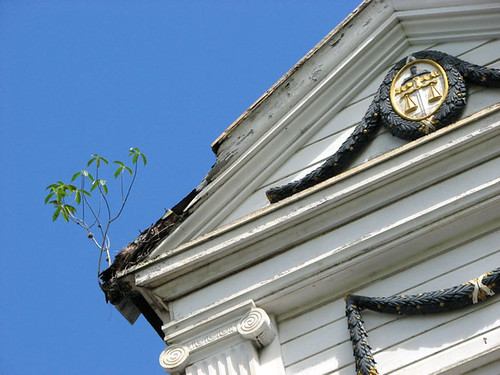
Detail of the façade of the Hof van Justitie in Paramaribo; photo by Nicholas Laughlin, 28 June, 2009
Labels: architecture, conjunction, cozier, laughlin
Topography: minibus, Waterkant
Monday, February 8, 2010
Labels: minibus, street painting, topography, waterkant
Project: Jeroen Jongeleen’s “culture hacking”
Friday, February 5, 2010
“Site & Content Specific Art (Practice)”, graffiti by Jeroen Jongeleen in the Palmentuin, Paramaribo; photo courtesy the artist
The Rotterdam-based artist Jeroen Jongeleen, one of the participants in the ArtRoPa exchange programme, spent several weeks in Paramaribo in late 2007 and early 2008. Here the Dutch critic Siebe Thissen describes Jongeleen’s work in Paramaribo, in an excerpt from a longer essay in the Paramaribo SPAN catalogue.
Jeroen Jongeleen’s work in Paramaribo staged an encounter between street images and the visual arts. Jongeleen plastered graffiti slogans in the city where he had spent his youth. With not a little irony, he sprayed the words “art in public spaces” on a neglected little concrete structure in the Palmentuin [Palm Gardens] — a nocturnal haunt for Paramaribo’s junkies.
“Buiten Kunst uit Rotterdam” (“Public Art from Rotterdam”), graffiti by Jeroen Jongeleen in Paramaribo; photo courtesy the artist
Jongeleen also added a monumental feature at the corner of Wanicastraat and Sophie Redmondstraat, close to the US Embassy. UNESCO may have declared Paramaribo’s old, well-preserved city centre a world heritage site, but small wooden workers’ houses, many of which have been neglected, do not enjoy that protection. Jongeleen painted one of those unlisted houses completely white, with window frames in light blue — the colour of UNESCO. His action introduced a new element into the visual culture of Paramaribo: “culture hacking”, or the power of art to react to and comment on the surrounding visual culture.
Painted house at 59 Wanicastraat; photo courtesy the artist
Labels: architecture, graffiti, jongeleen, palmentuin, project, thissen
Notes: other canvases
Wednesday, February 3, 2010
By Christopher Cozier
Kali tattoo, by Pierre Bong a Jan; photo courtesy the artist
The idea of Pierre Bong a Jan using skin as another canvas coincides with the painted decorations on Paramaribo minibuses, reaching out to a larger contemporary public and extending the dialogue about visual production.
The buses and the tattoos, like t-shirts and angisa headkerchiefs, speak with and about the concerns of people living in this space, and also operate far away from traditional art spaces. As suggested by the art historian Kobena Mercer, they become “viral” in their vernacular forms, threatening to infect our much-cherished ideas about “ART”. It’s not just about surfaces, but also about iconography — the meeting point where traditions of body adornment and unlikely mythological confluences play out, as new identities and sensibilities are produced. Where else can a calendar Kali, Botticelli’s Venus, and the stylizations of Vargas or Frazetta meet, if not in Paramaribo?
Handmade tattoo machine; photo courtesy Pierre Bong a Jan
Tapping into a family tradition of ingenuity and self-determination, Bong a Jan has also made his own working tools and devices. His plan to do a live tattoo on the opening night of the SPAN exhibition engages my interest in the less declarative and more provisional implications of exhibitions as events. The artist, within his or her experimental pursuits, creates critical moments that seek to open up or expand our sense of what is possible or expected.
Like the home-manufactured confectionery of Ellen Ligteringen or George Struikelblok’s caged broilers, the event staged or generated is an experience that can live in our mind’s eye, like an encounter with an image — and can be internally processed, devoured, refashioned, and re-enacted. It is a proposal, a question in an ongoing visual conversation. Our presence or response makes or is an active element of the work, as much as we are also incorporated or co-opted within this moment.
Pierre Bong a Jan’s sketchbook, in his tattoo studio; photo courtesy the artist
Labels: bong a jan, cozier, notes, tattoo
Seen: Masters of the Game, by Jurgen Lisse
Monday, February 1, 2010
Masters of the Game from Jurgen Lisse on Vimeo.
Masters of the Game is a short video piece by filmmaker Jurgen Lisse, featuring the nimble footwork of a group of young street football players. Using camerawork and editing techniques familiar from music videos, set to a hard-driving soundtrack, it is an artifact of an international urban sensibility with various Paramaribo landmarks as backdrops.
Lisse writes:
“A few boys came to me and asked if I could help them with an intro for their team, Streetskillerz. These talented boys are still in school, and besides school they enjoy and challenge each other with passion and the quickest moves.”
See more of Lisse's short video works at Vimeo.
Labels: jurgen lisse, seen, video










